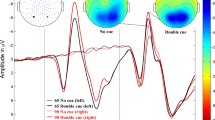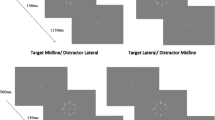Abstract
We investigated developmental differences in the cortical attention processing network using magnetoencephalography (MEG) and a spatial cueing task in 7–8 and 12–13 year old children. The cueing paradigm consisted of a centrally presented face with left or right averted eye-gaze in the gaze cue condition, and a central face with straight gaze presented with a cue stimulus to the left or right of the face in the peripheral cue condition. Cue congruency was 50 %. MEG was recorded during the two conditions and event-related beamforming was used to determine the timing and location of the brain activity related to target detection with the two types of cueing. The MEG data showed no age differences in the eye-gaze condition, but a developmental difference characterised by slower and more diffuse activations for peripheral cues in the younger versus the older age group. In the 7–8 year olds activation peaked around 300 ms, and was localised to left inferior frontal gyrus as well as posterior areas related to visuo-spatial processing. The 12–13 year olds showed a temporoparietal pattern of activation characteristic of spatial reorientation which resembled that seen for adult participants using the same paradigm (Nagata et al. 2012). The activation peaked around 200 ms and was localised to the left superior frontal gyrus, middle frontal gyrus but bilaterally near the temporoparietal junction. The data indicate maturational changes in brain activity for peripheral cueing.





Similar content being viewed by others
References
Akhtar N, Enns JT (1989) Relations between covert orienting and filtering in the development of visual attention. J Exp Child Psychol 48:315–334
Brahmbhatt SB, McAuley T, Barch DM (2008) Functional developmental similarities and differences in the neural correlates of verbal and nonverbal working memory tasks. Neuropsychologia 46:1020–1031
Brahmbhatt SB, White DA, Barch DM (2010) Developmental differences in sustained and transient activity underlying working memory. Brain Res 1354:140–151
Brodeur DA, Boden C (2000) The effects of spatial uncertainty and cue predictability on visual orienting in children. Cognit Dev 15:367–382
Corbetta M, Shulman GL (2002) Control of goal-directed and stimulus-driven attention in the brain. Nat Rev Neurosci 3:201–215
Corbetta M, Miezin FM, Shulman GL, Petersen SE (1993) A PET study of visuospatial attention. J Neurosci 13:1202–1226
Corbetta M, Patel G, Shulman GL (2008) The reorienting system of the human brain: from environment to theory of mind. Neuron 58:306–324
Driver J, Davis G, Ricciardelli P, Kidd P, Maxwell E, Baron-Cohen S (1999) Gaze perception triggers reflexive visuospatial orienting. Visual Cogn 6:509–540
Enns JT, Brodeur DA (1989) A developmental study of covert orienting to peripheral visual cues. J Exp Child Psychol 48:171–189
Friesen CK, Kingstone A (1998) The eyes have it! Reflexive orienting is triggered by nonpredictive gaze. Psychon B Rev 5:490–495
Friesen CK, Moore C, Kingstone A (2005) Does gaze direction really trigger a reflexive shift of spatial attention? Brain Cogn 57:66–69
Frischen A, Bayliss AP, Tipper SP (2007) Gaze cueing of attention: visual attention, social cognition, and individual differences. Psychol Bull 133:694–724
Goldberg MC, Maurer D, Lewis TL (2001) Developmental changes in attention: the effects of endogenous cueing and of distractors. Dev Sci 4:209–219
Greene DJ, Zaidel E (2011) Hemispheric differences in attentional orienting by social cues. Neuropsychologia 49:61–68
Greene DJ, Colich N, Iacoboni M, Zaidel E, Bookheimer SY, Dapretto M (2011) Atypical neural networks for social orienting in autism spectrum disorders. Neuroimage 56:354–362
Hietanen JK, Nummenmaa L, Nyman MJ, Parkkola R, Hamalainen H (2006) Automatic attention orienting by social and symbolic cues activates different neural networks: an fMRI study. Neuroimage 33:406–413
Hopfinger JB, West VM (2006) Interactions between endogenous and exogenous attention on cortical visual processing. Neuroimage 31:774–789
Itier RJ, Taylor MJ (2004) Effects of repetition and configural changes on the development of face recognition processes. Dev Sci 7:469–487
Jonides J, Irwin DE (1981) Capturing attention. Cognition 10:145–150
Kail R (1993) Processing time decreases globally at an exponential rate during childhood and adolescence. J Exp Child Psychol 56(2):254–265
Kail RV, Ferrer E (2007) Processing speed in childhood and adolescence: longitudinal models for examining developmental change. Child Dev 78(6):1760–1770
Kim Y-H, Gitelman DR, Nobre AC, Parrish TB, LaBar KS, Mesulam MM (1999) The large-scale neural network for spatial attention displays multifunctional overlap but differential asymmetry. Neuroimage 9:269–277
Kincade JM, Abrams RA, Astafiev SV, Shulman GL, Corbetta M (2005) An event-related functional magnetic resonance imaging study of voluntary and stimulus-driven orienting of attention. J Neurosci 25:4593–4604
Langton SR, Bruce V (1999) Reflexive visual orienting in response to the social attention of others. Visual Cogn 6:541–567
Mayer AR, Dorflinger JM, Rao SM, Seidenberg M (2004) Neural networks underlying endogenous and exogenous visual-spatial orienting. Neuroimage 23:534–541
Mills T, Lalancette M, Moses SN, Taylor MJ, Quraan MA (2012) Techniques for detection and localization of weak hippocampal and frontal sources using beamformers in MEG. Brain Topogr 25:248–263
Nagata Y, Bayless SJ, Mills T, Taylor MJ (2012) Spatio-temporal localisation of attentional orienting to gaze and peripheral cues. Brain Res 1439:44–53
Nobre AC, Sebestyen GN, Gitelman DR, Mesulam MM, Frackowiak RS, Frith CD (1997) Functional localization of the system for visuospatial attention using positron emission tomography. Brain 120(Pt 3):515–533
Peelen MV, Heslenfeld DJ, Theeuwes J (2004) Endogenous and exogenous attention shifts are mediated by the same large-scale neural network. Neuroimage 22:822–830
Posner MI (1980) Orienting of attention. Q J Exp Psychol 32:3–25
Quraan MA, Cheyne D (2010) Reconstruction of correlated brain activity with adaptive spatial filters in MEG. Neuroimage 49:2387–2400
Quraan MA, Moses SN, Hung Y, Mills T, Taylor MJ (2011) Detection and localization of hippocampal activity using beamformers with MEG: a detailed investigation using simulations and empirical data. Hum Brain Mapp 32:812–827
Robinson SE, Vrba J (1999) Recent advances in biomagnetism. In: Yoshimoto T, Kotani M, Kuriki S, Karibe S, Nakasato N (eds) Functional neuroimaging by synthetic aperture magnetometry (SAM). Tohoku University Press, Sendai, pp 302–305
Rosen AC, Rao SM, Caffarra P, Scaglioni A, Bobholz JA, Woodley SJ, Hammeke TA, Cunningham JM, Prieto TE, Binder JR (1999) Neural basis of endogenous and exogenous spatial orienting. A functional MRI study. J Cogn Neurosci 11:135–152
Schul R, Townsend J, Stiles J (2003) The development of attentional orienting during the school-age years. Dev Sci 6:262–272
Sekihara K, Nagarajan SS, Poeppel D, Marantz A, Miyashita Y (2001) Reconstructing spatio-temporal activities of neural sources using an MEG vector beamformer technique. IEEE Trans Biomed Eng 48:760–771
Senju A, Tojo Y, Dairoku H, Hasegawa T (2004) Reflexive orienting in response to eye gaze and an arrow in children with and without autism. J Child Psychol Psychiatry 45:445–458
Taylor MJ, Mills T, Pang EW (2011) The development of face recognition; hippocampal and frontal lobe contributions determined with MEG. Brain Topogr 24:261–270
Tipper CM, Handy TC, Giesbrecht B, Kingstone A (2008) Brain responses to biological relevance. J Cogn Neurosci 20:879–891
Vaidya CJ, Foss-Feig J, Shook D, Kaplan L, Kenworthy L, Gaillard WD (2011) Controlling attention to gaze and arrows in childhood: an fMRI study of typical development and autism spectrum disorders. Developmental Science 14:911–924
Vossel S, Weidner R, Thiel CM, Fink GR (2009) What is “odd” in Posner’s location-cueing paradigm? Neural responses to unexpected location and feature changes compared. J Cogn Neurosci 21:30–41
Wainwright A, Bryson SE (2002) The development of exogenous orienting: mechanisms of control. J Exp Child Psychol 82:141–155
Acknowledgments
The work was supported by CIHR funding to MJT (MOP 81161). We are grateful to Marc Lalancette for providing assistance with technical details and revisions to Fig. 4.
Author information
Authors and Affiliations
Corresponding author
Rights and permissions
About this article
Cite this article
Bayless, S.J., Nagata, Y., Mills, T. et al. MEG Measures of Covert Orienting and Gaze Processing in Children. Brain Topogr 26, 616–626 (2013). https://doi.org/10.1007/s10548-013-0279-9
Received:
Accepted:
Published:
Issue Date:
DOI: https://doi.org/10.1007/s10548-013-0279-9




